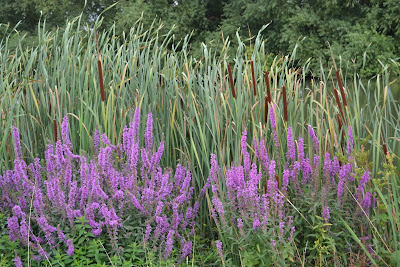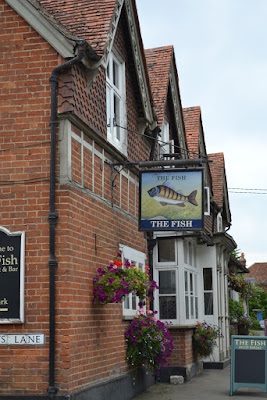18
August 2015 OS
Landranger 164
We began at the
car-park immediately south of Wittenham Clump SU5692. The Clump is a group of beech Fagus sylvatica crowning an outlier hill
rising immediately from the Thames , which,
while being of no great height, forms a landmark for miles around.
Wittenham Clump
Immediately above
the car-park is a prehistoric fort with deep ditches. Although on chalk the turf had few plants of
interest - woolly thistle Cirsium
eriophorum, chalk knapweed Centaurea
debeauxii, red bartsia Odontites
verna, agrimony Agrimonia eupatoria,
dwarf mallow Malva neglecta, black
horehound Ballota nigra.
Woolly thistle with common
ragwort
Dwarf mallow
Much of it was
rough grassland - a colony of welted thistle Carduus crispus had many seven-spot ladybirds, despite these
creatures having become much scarcer recently.
Welted thistle with 7-spot
ladybirds
A large bright
pink flower close to the ground had us wondering for a moment, but it was only
an escaped garden tree mallow Malva x
clementii that was lying down rather than standing erect. There were a lot of these growing at the
Earth Trust Centre close to Wittenham Clump and it was obviously the source of
this errant plant - amusing to think that this environmental organisation could
be responsible for the countryside being overrun by aliens it has introduced!
Garden tree mallow with
clustered dock
We walked from the
fort northwards beside Little Wittenham Wood, a nature reserve with open
access. Along the edge were the expected
plants like spindle Euonymus eyropaeus,
guelder rose Viburnum opulus, black
bryony Tamus communis, hawthorn Crataegus monogyna, hairy StJohn's-wort Hypericum hirsutum and wild parsnip Pastinaca sativa.
Spindle berries not yet
ripe
On the downward
slope we passed through a meadow with lots of yellow rattle Rhinanthus minor, some musk mallow Malva moschata and chicory Cichorium intybus, a plant that always
flowers when summer has passed its best.
There was a good view down to the Thames .
Chicory
A dried-up pond
lower down the meadow gave us the first water plants that would mostly be seen
again along the Thames - greater pond sedge Carex
riparia, false fox sedge C. otrubae,
hairy sedge Carex hirta, purple
loosestrife Lythrum salicaria, water
mint Mentha aquatica, gypsywort Leucopus europaeus, and yellow iris Iris pseudacorus. There was also a bush of downy rose Rosa tomentosa. A ditch close to the village of Little
Wittenham added bulrush Typha latifolia,
meadowsweet Filipendula ulmaria and
great willowherb Epilobium hirsutum,
as well as leaves of meadow cranesbill Geranium
pratense.
Great willowherb
In Little
Wittenham village it was a very short walk down the track past the church to
the river.
The churchyard
seemed to favour horse-chestnut Easculus
hippocastanum and lime-trees Tilia x
europaea to the usual yews, but opposite it there stood an unfamiliar
hawthorn, which we later keyed out to Crataegus
rhipidophylla or large-sepalled hawthorn.
It had well-cut leaves that varied immensely in size and persistent
sepals on the haws.
Large-sepalled hawthorn
Leaves and fruit of
large-sepalled hawthorn
At the bottom of
the track was a hedge of butcher's broom Ruscus
aculeatus and small balsam Impatiens
parviflora in a side-stream of the Thames . At the river itself, which we crossed by a
bridge and then re-crossed to the west bank at a weir, we saw additional
waterside plants - marsh woundwort Stachys
palustris, common clubrush Schoenoplectus
lacustris with its grey stems, common fleabane Pulicaria dysenterica, hemlock water-dropwort Oenanthe crocata, wild angelica Angelica
sylvestris, yellow water-lily Nymphoides
peltata and two more balsams - Indian and orange Impatiens glandulifera and I.
capensis. The first heron of the day
rose up with a harsh cry, but we were to see plenty more through the day.
Common clubrush under
crack willow
Common fleabane
At the weir we
passed over Day's Lock where boats were just being let through by the
lock-keeper.
Day's Lock
Here we saw
pellitory-of-the-wall Parietaria judaica,
dewberry Rubus caesius and wood
horsetail Equisetum sylvaticum with
its distinctive branched branches.
Wood horsetail
The bank north of
here had a series of old crack willow Salix
fragilis pollards, along with old ash Fraxinus
excelsior and alder Alnus glutinosa
trees.
Crack willow pollards
One of the willows
had fungi at the base of somewhat anonymous appearance until closer examination
showed that they had a thick ring around the stem and a very long tap-root,
sufficient to identify them as rooting poisonpie Hebeloma radicosum. The long
root in this species comes from underground dead bodies (eg mole), so that its
association in this case with the willow was incidental, there presumably being
mammal burrows beneath it and its hollow interior.
Rooting poisonpie in situ
Specimen showing ring and
long root
Just past this
tree was an old ash with shaggy bracket Inonotus
hispidus.
Shaggy bracket on ash
trunk
As walked along we
were struck by the fact that the river provided a narrow colourful oasis of
flowers in sharp contrast to the green but largely flower-less fields to the
other side of us.
Purple loosestrife and
bulrush by the Thames
We continued to
add a few species to our list - brooklime Veronica
beccabunga, water forgetmenot Myosotis
scorpioides, reed Phragmites
australis, hard rush Juncus inflexus,
square-stemmed StJohn's-wort Hypericum
tetrapterum, water figwort Scrophularia
aquatica, common skullcap Scutellaria
galericulata, great water dock Rumex
hydolapathum, water chickweed Myosoton
aquaticum, hemp agrimony Eupatorium
cannabinum and celery-leaved buttercup Ranunculus
sceleratus.
Water chickweed
Great water dock
Among these
natives were frequent colonies of escaped common Michaelmas-daisy Aster x salignus.
Common Michaelmas-daisy
We had been hoping
to find greater dodder along here on riverside nettles Urtica dioica, but these had been sparse until we got very close to
Clifton Hampden, where we came across a large colony - but still no dodder,
which has eluded us in every trip we have taken beside the Thames ,
although this is its locus classicus. The only compensation as we approached the
village was a tree of Midland hawthorn Crataegus laevigata and a flock of
goldfinches on seeding spear thistles Cirsium
vulgare.
Midland hawthorn
We then crossed
the Thames by a road bridge, where there was
greater celandine Chelidonium majus
and a walnut tree Juglans regia, and
continued west along the other bank of the river. The vegetation along here was bushier and
rougher and less rewarding, but hop Humulus
lupulus was frequent and we added hedgerow cranesbill Geranium pyrenaicum, rest-harrow Ononis repens and common buckthorn Rhamnus catharticum.
A low wet meadow had lots of wild
angelica and also the true native form of common comfrey Symphytum officinale with its creamy flowers.
Wet meadow with wild
angelica
Common comfrey
A bare arable
field also provided black nightshade Solanum
nigrum, field pansy Viola arvensis,
common poppy Papaver rhoeas and
bristly ox-tongue Helminthotheca
echioides. The land had had
dredgings from the river thrown on it, including shells of the swollen river
mussel Unio tumidus.
Swollen river mussel
After crossing the
railway line and under a line of pylons, both from Didcot and its power
station, we arrived at Culham where there was another bridge to take us across
to Sutton Courtenay and the end of our exploration of the river. At the bridge were wall-rue Asplenium ruta-muraria and fruiting
cherry-plums Prunus cerasifera with
golden yellow fruit. The Fish Restaurant
on the village provided a welcome lunch opportunity and rest.
After lunch we
walked south past the church to the region of former gravel-pits where we
turned east past several lakes. The
white water-lilies Nymphaea alba here
were introduced, as they included several cultivars of various colour and the
blue globe-thistles Echinops bannaticus
were obviously garden escapes, although the water horsetails Equisetum fluviatile may possibly have
come in naturally. There was view across
one lake to Didcot Power Station.
Blue globe-thistle
We then came
across a bare dry field that was probably wet in the winter and had a number of
arable plants, although it was dominated by a vigorous grass which was
spreading by underground stolons and had long narrow leaves with prominent
white mid-ribs. This turned out to be
Chinese silver-grass Miscanthus sinensis,
which is grown as an ornamental in gardens and also used as a bio-crop. We do not know the origin of this field of
alien grass - perhaps it was a planted bio-crop in itself. It does not flower until September or October.
Chinese silver-grass
The more expected
"weeds" here were: frequent round-leaved fluellen Kickxia spuria, very little sharp-leaved
fluellen K. elatine, a little bugloss
Anchusa arvensis, many-seeded and
maple-leaved goosefoots (goosefeet?) Chenopodium
polyspermum & C. hybridum,
black bindweed Fallopia convolvulus,
scarlet pimpernel Anagallis arvensis,
wild basil Clinopodioum vulgare, frequent
common orache Atriplex patula,
abundant rough sow-thistle Sonchus asper,
frequent square-stemmed willowherb Epilobium
tetragonum, dwarf mallow and much redleg Persicaria maculata (many plants with greenish flowers and
unspotted leaves, making them confusable with pale persicaria).
Bugloss
Round-leaved fluellen
Many-seeded goosefoot
Maple-leaved goosefoot
Redleg - green flowers
We saw the violet
ground beetle Carabus violaceus here.
Violet ground beetle
When we reached a
cross-track the footpath ahead (which would have taken us to the outskirts of
Appleford) was blocked and supposedly re-routed, but the path was now unkempt
and difficult and in places non-existent or impassable. This was probably in connection with plans
for a new quarry, signs opposing which we saw all over Appleford when we got
there. Certainly the footpath mitigation
was not adequate. At one point through
this difficult section we passed blue fleabane Erigeron acer and the uncommon narrow-leaved birdsfoot-trefoil Lotus glaber, much slenderer and wirier
than the common species.
Narrow-leaved
birdsfoot-trefoil
We eventually came
out along the road into Appleford (though further away than the original footpath),
passing aspens Populus tremula. We kept an eye open for apple Malus pumila in the hedges, given that
this village is named for this tree, which must have been cultivated here long
ago, but it was not until we emerged on the other side that we found some in a
field hedge.
Apples for Appleford
The path continued
to Long Wittenham, coming quite close to the Thames
once more. As we entered the village we
passed naturalised lilac Syringa vulgaris
and viper's bugloss Echium vulgare. At the main road through the village we
turned NE, passing a planted hawthorn that had unusually flattened haws. Checking this thoroughly later it was
inseparable from Midland hawthorn, although we
can find no pictures of this (or a hybrid) with such flattened fruits.
Midland hawthorn with
conspicuously flattened haws, planted in Long Wittenham
From the north end
of this village a road and then paths take one to Little Wittenham and then
back up the steep hill to Wittenham Clump and the end of the walk.











































No comments:
Post a Comment